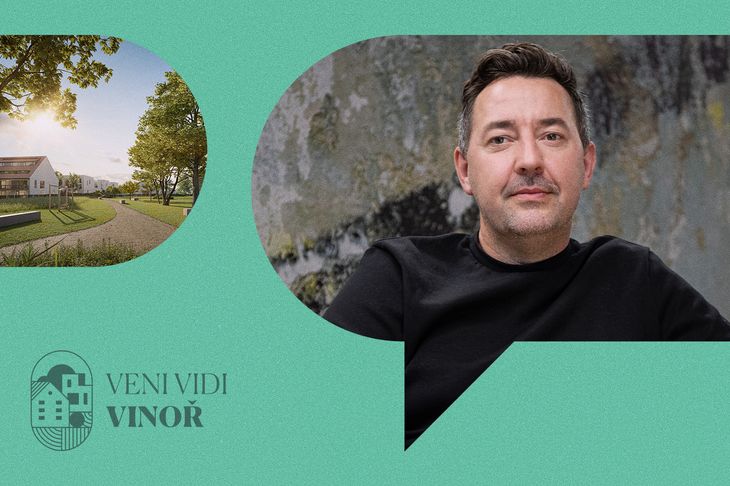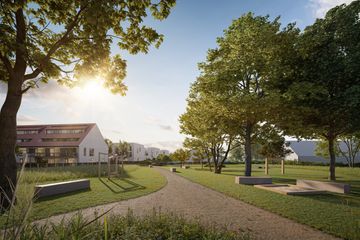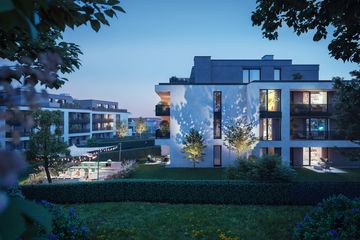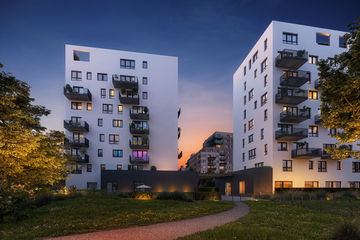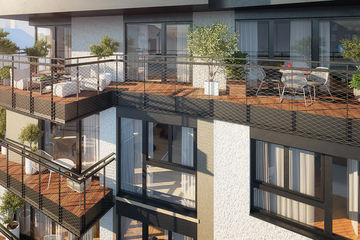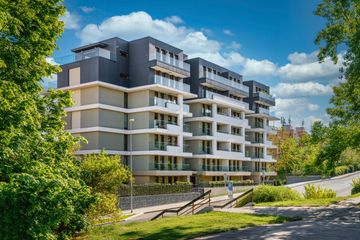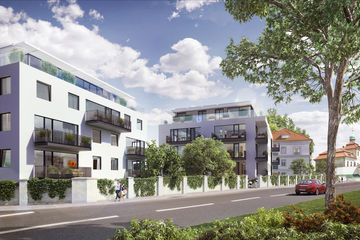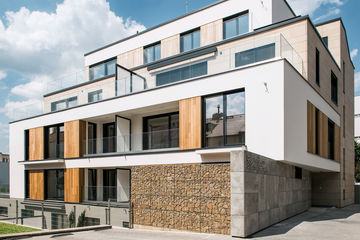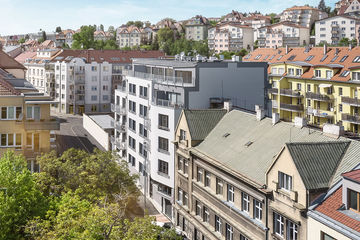How would you yourself introduce the Veni Vidi Vinoř development?
It’s a mid-sized residential project in a fantastic location. The size of the property guarantees that this is a place with plenty of “room to breathe”. The development has just 134 units spread out over a 30,000 m² site, and the buildings have no more than four storeys. We see Vinoř as an undiscovered gem in what will become a very popular area. Our development has been designed to respect the tranquil nature of Vinoř, both in terms of architecture and housing density—which, given the size of the land, is minimal.
The development connects history with the present. Where did this idea come from?
This concept arose partly because of two listed buildings at the site. The history behind the steward’s estate and its distinctive architecture, which made it possible to create a courtyard, determined the course we took in the design. We underlined this concept with saddle-roofed buildings no more than four storeys high as the development project’s dominant feature.
The architectural studio, Quarta Architektura, is experienced with buildings where history meets the present. Did this play a role in the decision process?
Absolutely. Quarta is a leading player and ensures a professional and sensitive approach towards the development project. I should add that the project had to be reworked several times, and the final blueprint is the result of nearly six years of planning.
What inspired you about Vinoř to convince you that it should be the site of Neocity’s next development project? How would you introduce this site to people who aren’t familiar with it?
The first visit to Vinoř revealed just how remarkable the location is. The expansive former steward’s estate offers something unusual, allowing the creation of a “closed” community development project. I’m intentionally using scare quotes around the word “closed”. Neocity’s aim is to create an oasis for the future owners, but we don’t want it to be isolated from the surrounding area. We want our developments to be integrated into the evolution of the area—in this case, Vinoř.
These days Vinoř is a city district, but in the past, it was a village. What has played a role in Neocity deciding to build on the “fringes” of Prague, unlike other projects?
When we select a location, we don’t let ourselves be bound by predetermined rules. If we did, we never would have discovered Vinoř, and we would have wasted the chance to create something this exclusive and interesting. Although it’s located on the edge of Prague, Vinoř offers convenient access to the centre—via train from nearby Satalice or by bus to Letňany metro station.
How is Vinoř doing in terms of infrastructure? What can we expect in the future?
The infrastructure in Vinoř keeps improving, which is because interest in this attractive part of Prague is gradually increasing. Neocity itself has actively contributed to infrastructure improvements, for example by supporting and financing the installation of new traffic lights at the crossroads of Mladoboleslavská and Živanická. This project has long been on the table, and we’re pleased we could make a significant contribution to making it happen. Work is slated to start in 2024.
Did the development project change at all during the planning process? Has the market situation of the past eighteen months affected it?
Yes, the project has undergone changes, mainly in response to demands from neighbours and the City District of Prague–Vinoř. The final blueprint of Vini Vidi Vinoř is a compromise, and we spent six years working towards getting approval. Although the approval process is lengthy, while it’s underway there isn’t much space to respond flexibly to the market changes of the past year or two. However, Neocity is trying to avoid falling into the trap that other developers have fallen into—that price is the sole decisive factor. If someone offers something at a cheaper price, it is often reflected in the quality of the work and the standards. This principle applies to a variety of areas, and housing is no exception.
Besides flats, does the property offer anything more?
Most importantly, the property offers plenty of space for living. The development project includes a central reception for receiving parcels and letters, which future residents will welcome when they aren’t at home. We’re also thinking about adding parcel delivery and collection lockers, but we’re going to be careful about that because we don’t want to end up creating a parcel delivery hub for the whole of Vinoř. We also need to remember that the development project includes a 10,000 m² park which provides plenty of peace and quiet for a range of activities. The planned new town hall near the entrance to the “steward’s estate” and the generous adjoining 6,000 m² courtyard are without a doubt added value for residents.
All car parking will be centralised in underground garages at the complex. What led you to decide on this solution?
We preferred this solution from the very outset, and it corresponded with the project’s concept of minimising car traffic. This solution can’t always be used, but it links very well with the architecture of Veni Vidi Vinoř. We expect that many families with children will live here, and it’s essential that parents rest assured that cars travelling through the area won’t pose a risk to children playing outdoors.
What makes work on this development different from Neocity’s other developments?
The main difference is in the area and its size. We haven’t always been able to find such a spacious site. We’ve also taken a sensitive approach towards housing density. The size of the site would let us build twice as many flats, but our aim has been to preserve its tranquillity and to not create yet another housing estate. We’ll leave that to others.
This is Neocity’s largest development project in the Czech Republic to date. Do you see it as a sort of milestone? Are you planning to continue at this scale, or will you go back to smaller developments?
It’s our understanding that a development project with more than one hundred, one hundred and fifty flats is Neocity’s cut-off point. It isn’t that Neocity wouldn’t be able to build a larger development project—after more than twenty years on the market, we have a solid position with banks and construction companies and we’re a respected partner. There are imitations associated with massive developments of several hundred units—they generate a lot of challenges, including major fluctuations in tenants and owners, and they require large investments in maintenance, which could adversely impact any future sales price of the property.
Could you please summarise Veni Vidi Vinoř’s target group of people? What sort of people would find their dream home there?
Veni Vidi Vinoř is most definitely for people who want to live there long term, which is reflected in the total number of flats, how parking is laid out, and the sizes of the units. You won’t find any super-optimised investment flats there that already look small on paper and even in real life fall far short of what a decent place to live should be. We try to create flats that will become homes.


